We got up early after fighting giant mosquitos all night. We had signed up for a 2-day tour that would take us to Delphi and Meteora. We packed up and headed to a hotel lobby to meet the tour bus. We were on the road a bit before 9 am.
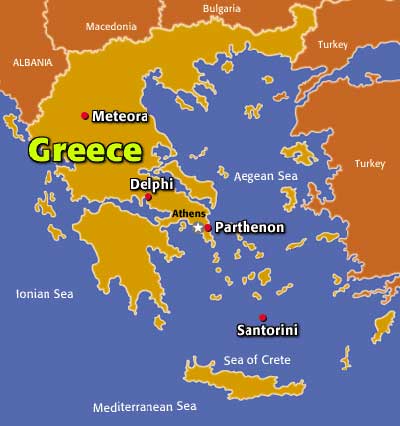
It's about 220 miles from Athens to Meteora.

The rather graphic sign above the bathroom on the bus
After a while, we left the bigger national road for provincial roads that carried us through plains and across mountains.
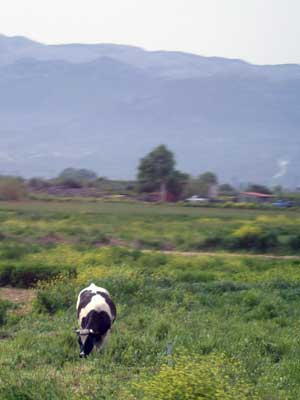
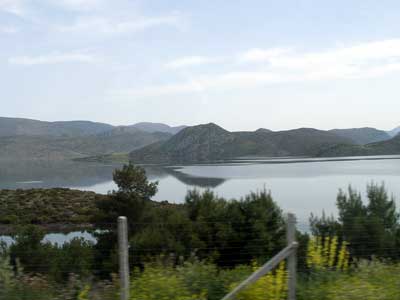
A grazing bovine... and Lake Yliki

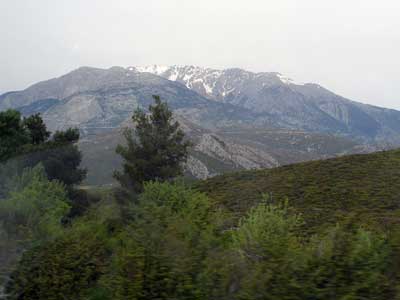
Mt. Parnassus (elevation 8,061) was home of the Muses (the inspirational goddesses of literature, science and the arts). 80% of the Greek mainland is mountains, including a southern extension of the Alps. Vegetation doesn't grow above 8,200 feet.
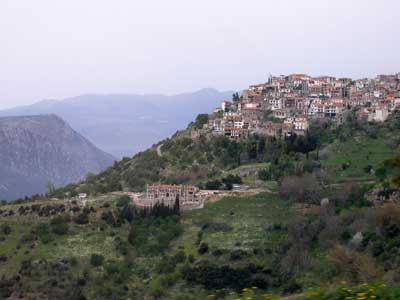
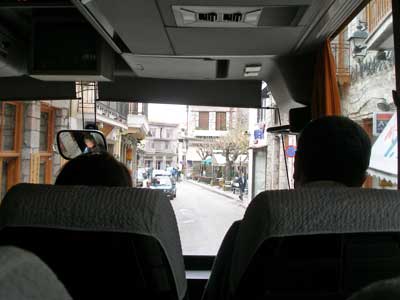
Arachova is a small, traditional mountain town... complete with narrow streets that the bus somehow managed to squeeze through!
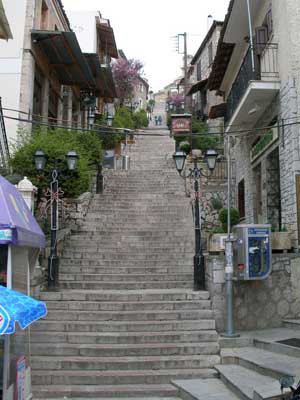

Quick views up side streets
Delphi has been a religious center since 1600 BC where it was first a place of worship of the earth goddess and later of Apollo. By the 8th century BC, it had acquired international fame for its accurate predictions of the future. Generals, kings and even common folk consulted the oracle of Delphi on matters ranging from family disputes to the decision to go to war. Questions were asked to the Pythia, or high priestess, who muttered incomprehensible sounds during a state of trance. These were then ambiguously translated as to be interpreted several different ways.
The original name of this site was Krisa and it was guarded by Python (a giant serpent who was the son of Gaia, or Earth) to protect the center of the world. After he was slain by Apollo, his body fell into a deep chasm where it began to decompose (the word pytho means to rot). The Pythia (or Oracle of Delphi) was one of many young girls from wealthy families. Clothed in white robes, she lived in Delphi... drinking from the sacred spring, chewing on laurel leaves (which were possibly oleander whose toxic substances would result in symptoms similar to those of epilepsy) and inhaling vapors believed to be from the decaying Python that flowed from a cleft in a rock (which could have been high in hydrocarbons known to produce violent trances), which would put her in an altered state and allow her to express the will of Apollo. It wouldn't be surprising if many girls died doing all this. Later it was decided that the oracle had to be a woman over 50 whose had led an exemplary life.
In 83 BC, a Thracian tribe plundered the sanctuary and burned the temple. That same year, an earthquake further damaged the site. The Oracle fell in decay and its credibility waned. It flourished again briefly, but the rise of Christianity across the Roman Empire left little room for polytheism. All sanctuaries were closed; stones were pulled down and reused; and zealots destroyed most of the statues and works of art in an attempt to remove all traces of Paganism. The site was abandoned in the 6th or 7th century. It wasn't until the late 1800's that archeologists began undertaking excavations.
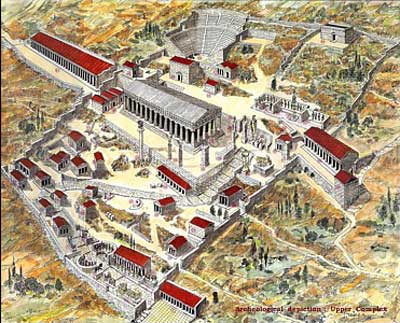
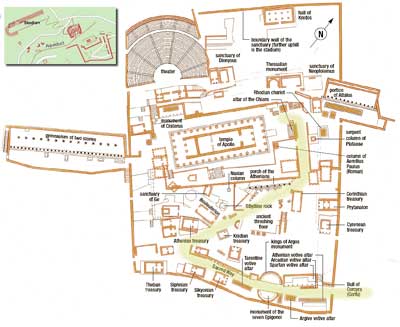
An illustration of how it may have once looked... and a map of the ruins today (click for a larger view)
Our walk would take us along the Sacred Way, past the amphitheater and finally ending in the stadium.
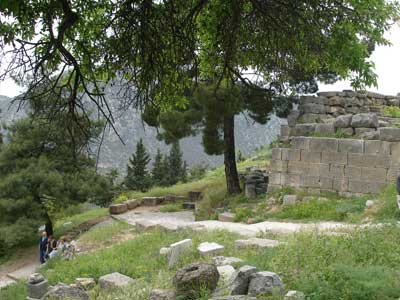
Remains of the old surrounding wall

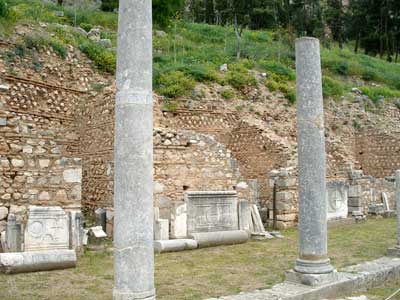
The Monument of the Arcadians was built in 369 BC to commemorate their recent victory over the Spartans in the neighboring region of Laconia/Lacedaemonia. It supported 9 bronze statues, including Apollo, Nike (Victory), Callisto (mother of the Arcadians) and six Arcadian heroes. The Arcadians are considered one of the oldest Greek tribes.
In later times ithis area was used as a form, with a large open marketplace and shops at the back.
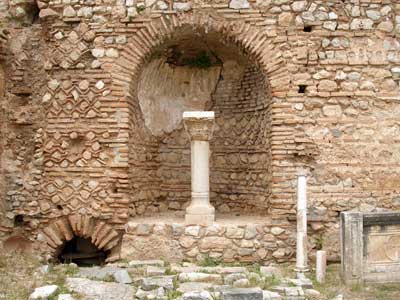
The statues were all melted down or sent to Rome (by Emperor Nero).
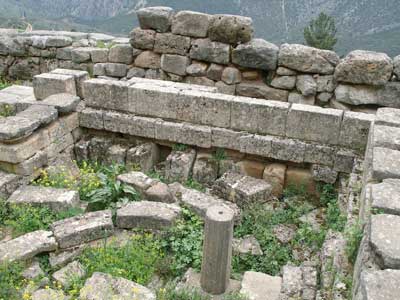
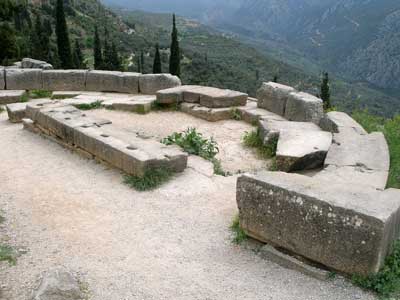
An old altar... and the semi-circular Monument of the Seven Epigoni.
When Oedipus, King of Thebes, realized he had killed his father and married his own mother, he blinded himself and cursed his two sons to divide the kingdom by war. The sons, in order to avoid bloodshed, agreed to rule Thebes in alternate years. But of course after just one year, the first son refused to step down, which of course led to war by the second son who raised and army of Argives (from Argos) to take Thebes by force (the Seven Against Thebes). It didn't go very well for them, so 10 years later, the Epigoni (meaning offspring) engaged in the second Theban war, wishing to avenge the death of their fathers. They were more successful and the Thebans were defeated.
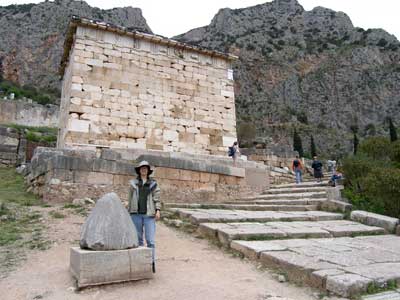
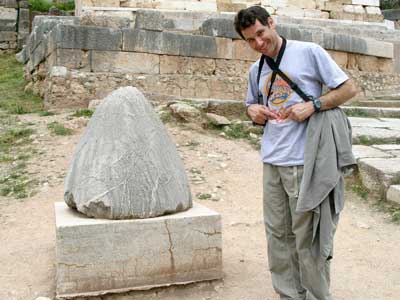
Delphi was considered to be the center (or Omphalos, which means navel) of the world. This stone marks the spot where two eagles that Zeus had sent in opposite directions met.
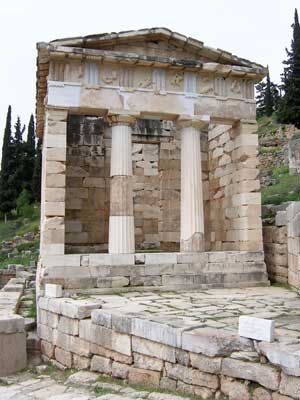
The Athenian Treasury was built of marble sometime between 510 and 480 BC and used to house much wealth in the form of donations to the temple. It was mostly destroyed but reconstructed in 1903 using mostly original stone.
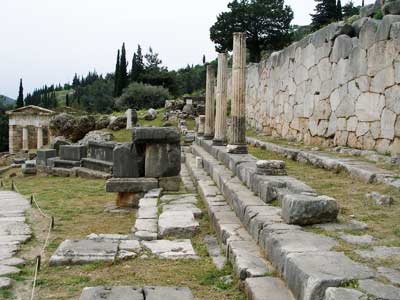
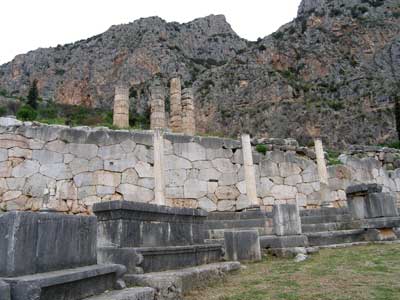
The treasury and the Stoa of the Athenians. The wall contains 800 different stones.
A stoa was a long covered walkway (or portico), commonly for public use. This one, with columns on one side and a retaining wall supporting the terrace of the Temple of Apollo on the other, was most likely covered with a wooden roof. Built around 478 BC, it was meant to celebrate Athenian victory over the Persians. It was decorated with ropes and the figureheads of the ships that they seized from the enemy.
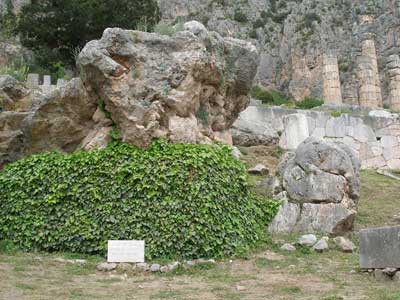
Sybil rock is supposedly where the vapors emerged.
Before the Pythia there was the Sibyl, a mythical woman from around the 8th century BC who was "born between man and goddess, daughter of sea monsters and an immortal nymph." After surviving nine generations of men, it was said that she became a wandering voice that still carried tidings of the future wrapped in dark riddles. In general, sibyls (from the ancient Greek meaning "divine counsel") were prophetic women of any age who were usually linked with caves or springs, both of which are symbolic connections to the underworld.
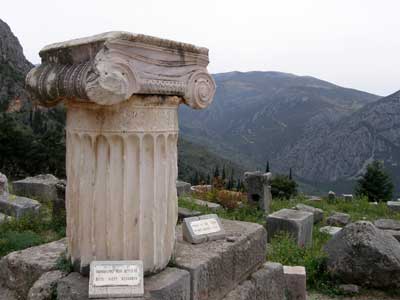
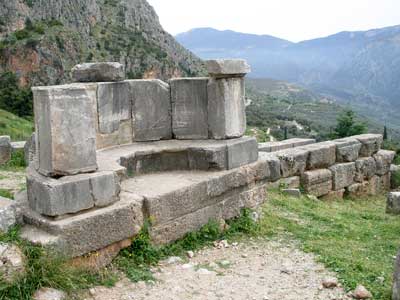
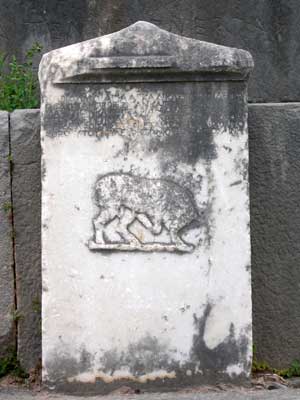
A marble slab with the image of a bull. After Hercules was driven mad and killed his own sons, he traveled to Delphi in hopes of redeeming himself. Thus was born his twelve labors. The seventh one was to capture the Cretan Bull, where it was wreaking havoc on Crete.

The end of the Sacred Way and the start of the Temple of Apollo
The temple was first built around the 7th century BC. It was rebuilt after a fire in the 6th century BC and again in 330 BC after an earthquake. It was further destroyed in 390 in the name of Christianity. Today all we have is the foundation and a few several Doric columns, which were erected during excavations.
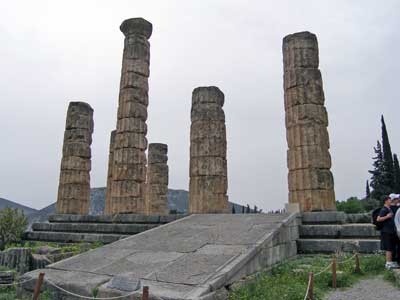
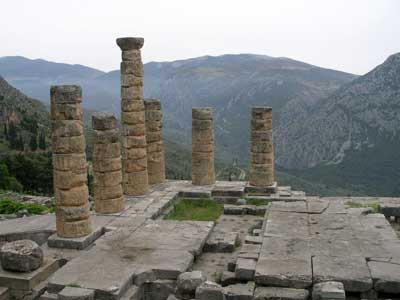
Ramps, not steps, were common in the Peloponnese... The top of the temple